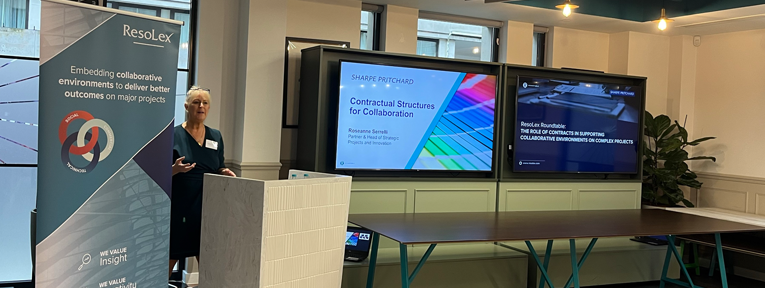On the 23rd of April, we welcomed Roseanne Serrelli, Partner at Sharpe Pritchard for a discussion on how contracts can be used to help embed collaborative behaviours on complex projects.
The session was opened by our Chief Executive, Edward Moore, who gave the attendees an overview of the evening and an introduction to the topic.
Ros began her presentation by explaining that the terms used in these ‘collaborative contracts’, e.g. alliances, enterprises, partnerships – have no specific legal definition. Any individual party involved with the contract is likely to interpret these terms differently. The key when looking to develop a contract which supports a collaborative endeavour is to focus on attention on the purpose of the relationship, rather than the term used. This approach has the benefit of shifting the focus away from risk transfer and instead puts the focus on risk avoidance and resolution.
The level of collaboration built into a contract can therefore be bespoke based upon the need, rather than starting with a pre-populated document. Options exist along on a spectrum from a light-touch arrangement to full alliances with shared legal risk, reward and finances. When developing a contract, it is worth thinking of the options as a menu from which the appropriate provisions can be selected based upon what the client intends to achieve.
Ros talked through several examples of different collaboration systems in existence, some of which have been discussed at previous ResoLex roundtables:
- Project 13 – not a contract itself, but an ecosystem and ethos for delivery that focuses on achieving outcomes rather than on the inputs.
- NEC Alliance – a single contract to which all are parties, including the client. This often works better on an ongoing programme with repeatable work, where the goal is to incentivise shared responsibility. This is more difficult on single projects where there may be more single points of failure that cannot be shared easily between participants.
- X12 – An option within NEC contracts that seeks to support multi-party collaboration, including containing a common set of objectives for all parties.
- FAC1 – An overarching framework that sits above individual contracts and contains items that need to be supported by those contracts, such as early warning systems.
Regardless of the form of the contract, there were some key takeaways about what is needed to ensure collaboration can be effectively supported:
- A defined governance structure with clear roles and accountabilities (often in a RACI matrix) – make it straightforward for people to understand who is doing what in the contract environment (and be clear that accountability is not the same as liability!)
- A clear decision-making process – the process may evolve over the lifetime of a project or differ in different parts of a programme, but it needs to be set out clearly and communicated to everyone involved.
- Set up Core Groups and Boards – these do not need to be over-engineered. They should have clearly defined objectives and discussion/decision points.
These structures provide a foundation for a successful collaboration. Having a contract that does not enable the environment you want will undermine your project from the start, though equally, having the perfect contract is meaningless if people do not engage in the right ways of working.
The contract underpins the practical side of collaboration; namely regarding people and their behaviours. When setting up for success, the behaviour of the joint team will be a key factor in how the benefits of these structures and processes are maximised in the project or programme environment.
The development of appropriate ways of working should consider some key questions, including but not limited to:
- Will the arrangement require co-location or jointly employed resources?
- What is the communications strategy? Will there be joint messaging from all parties? Will there be common branding and a ‘united front’ when facing the public?
- What are the processes for change or bringing in new people?
- What is the process for sub-contracting? Does the client need to approve any additions?
- How is the project insulated from outside noise (e.g. political pressures) to enable the team to focus on delivering the outcome?
- What do you do when things go wrong? It cannot be assumed, even with the perfect contract and the best people for the job, that there will never be an issue or point of contention between the parties. Provisions should be included in the agreement to enable parties to exit as necessary. Though counterintuitive, Ros shared that her experience is that providing clarity about the exit process provides comfort to the parties and in fact, often encourages parties to stay in contract and work through the challenges.
The session closed with a stimulating discussion on what needs to be done to try to build more collaborative environments in projects and programmes and how contracts can facilitate that, recognising that they are usually the starting point for the relationship. Points were raised in the room on the importance of ‘selling’ the benefits of this approach, particularly to clients when setting up a project and to politicians who may be overseeing major schemes. The conversation was a good reminder of the need to take the time to clearly define the required outputs and outcomes of a scheme before diving in, in order to set up the contract and environment that best facilitates these outcomes.
